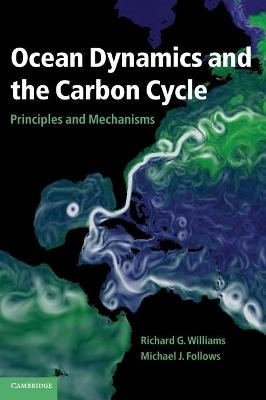
Ocean Dynamics and the Carbon Cycle
Cambridge University Press (Verlag)
978-0-521-84369-0 (ISBN)
This textbook for advanced undergraduate and graduate students presents a multidisciplinary approach to understanding ocean circulation and how it drives and controls marine biogeochemistry and biological productivity at a global scale. Background chapters on ocean physics, chemistry and biology provide students with the tools to examine the range of large-scale physical and dynamic phenomena that control the ocean carbon cycle and its interaction with the atmosphere. Throughout the text observational data is integrated with basic physical theory to address cutting-edge research questions in ocean biogeochemistry. Simple theoretical models, data plots and schematic illustrations summarise key results and connect the physical theory to real observations. Advanced mathematics is provided in boxes and appendices where it can be drawn on to assist with the worked examples and homework exercises available online. Further reading lists for each chapter and a comprehensive glossary provide students and instructors with a complete learning package.
Ric Williams is a Professor of Ocean Sciences at Liverpool University. He has worked on a wide range of research problems in Ocean Sciences: how the ocean circulates, how heat is transported, how the supply of nutrients sustains phytoplankton growth and how carbon is partitioned between the atmosphere and ocean. He teaches two courses to undergraduates, 'Climate, Atmospheres and Oceans' and 'Ocean Dynamics'. Mick Follows obtained a Ph.D. in Atmospheric Sciences from the University of East Anglia in 1991. After a year as a Royal Society Post-Doctoral Fellow at the Max Planck Institute for Chemistry in Mainz, Germany, he moved to the Massachusetts Institute of Technology where he is now a Senior Research Scientist in the Department for Earth, Atmospheric and Planetary Sciences. His research is focused on understanding the interplay of physical, chemical and biological processes which determines the distributions and fluxes of elements in the ocean.
Preface; List of symbols; Part I. Introduction: 1. Why is the ocean important?; 2. An introductory view of the ocean; Part II. Fundamentals: 3. Transport fundamentals; 4. Physics fundamentals; 5. Fundamental biological processes; 6. Carbonate chemistry fundamentals; Part III. Physical Phenomena and their Biogeochemical Signals: 7. Seasonality of the upper ocean; 8. Ocean gyres and intense currents; 9. Ocean eddies; 10. Ventilation; 11. Cycling and transport of nutrients and carbon; 12. The deep ocean and meridional overturning; Part IV. Synthesis: 13. Integral frameworks; 14. A forward view; Appendix: mathematical definitions and momentum equations; Glossary; Answers; References; Index.
| Erscheint lt. Verlag | 14.7.2011 |
|---|---|
| Zusatzinfo | Worked examples or Exercises; 15 Tables, black and white; 16 Plates, color; 286 Halftones, black and white |
| Verlagsort | Cambridge |
| Sprache | englisch |
| Maße | 196 x 254 mm |
| Gewicht | 1060 g |
| Themenwelt | Naturwissenschaften ► Geowissenschaften ► Geologie |
| Naturwissenschaften ► Geowissenschaften ► Hydrologie / Ozeanografie | |
| Naturwissenschaften ► Geowissenschaften ► Meteorologie / Klimatologie | |
| ISBN-10 | 0-521-84369-3 / 0521843693 |
| ISBN-13 | 978-0-521-84369-0 / 9780521843690 |
| Zustand | Neuware |
| Haben Sie eine Frage zum Produkt? |
aus dem Bereich


